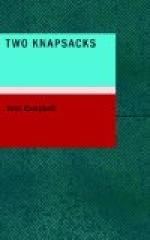“I should like to place these boards,” said Wilkinson, as he surveyed first them and then the dug-out; “I should like to place these boards, one across the bow and the other across the stern, but I really cannot decide which is the bow and which is the stern.”
“She’s a sort of a fore and after, Wilks, like the slip-ferry steamboats. I think, if you could find a bit of chalk or charcoal, and write bow on one plank and stern on the other, it would make her ship-shape and settle the business.”
“I have no sympathy, Corry, with makeshifts and factitious devices. I wish to arrive at the true inwardness of this boat. At what end of a boat is the anchor let down?”
“In the Susan Thomas it was pretty near the bow, and I think I’ve seen yachts riding at anchor that way in Toronto harbour.”
“In the time of St. Paul, however, there were four anchors, if I remember aright, cast out of the stern.”
“I don’t see how the anchor is going to help us. This long Tom Coffin has nothing of the kind.”
“You are sadly deficient in observation, Corry, or you would have observed a rope, very much abraded indeed, but still a rope, by which the vessel may be said, even though figuratively, to be anchored to this stake.”
“It’s you’re the clever man, Wilks; education has done wonders for you. Now, I remember that rope is the painter; that’s what The Crew called it on the dingy, and of course it was fastened to the bow.”
“But to the stern of the larger vessel.”
“Yes, but here there is no larger vessel. If you want one, for argument sake, you’ll have to imagine the post to be it. The coffin is bow on to the shore.”
“Corry, I insist, if I am to trust myself to this craft, that you call it by some other name.”
“Were you ever in anything of the kind before, Wilks?”
“Never.”
“Nor I.” These simple words had in them a depth of meaning.
A young man came on to the bridge and leaned over the rail, looking at the fishermen. He was respectably clad in a farmer’s holiday suit, was tall, strongly built, and with good features that bore unmistakable marks of dissipation. “I’ll bet you that’s Ben Toner,” whispered the lawyer, who was examining the new-found bow prior to depositing his boards.
“Goin’ fishin’?” asked the new comer, in a not unpleasant voice.
“Yes,” replied Coristine; “we’re going in this—what do you call it?”
“Dug-out, and mighty poor at that. Fishin’s no good here now. River was a pardise for Trontah folks wunst, but it’s clean fished out. I seen fellers go to a ho-ul up thayer,” said the supposed Ben, pointing in the opposite direction, “and take out a hull barl-ful afore sundown. ’Taint to be did, not now, wuss luck! Wait to I come down, and I’ll haylp you off with that kinew.”




